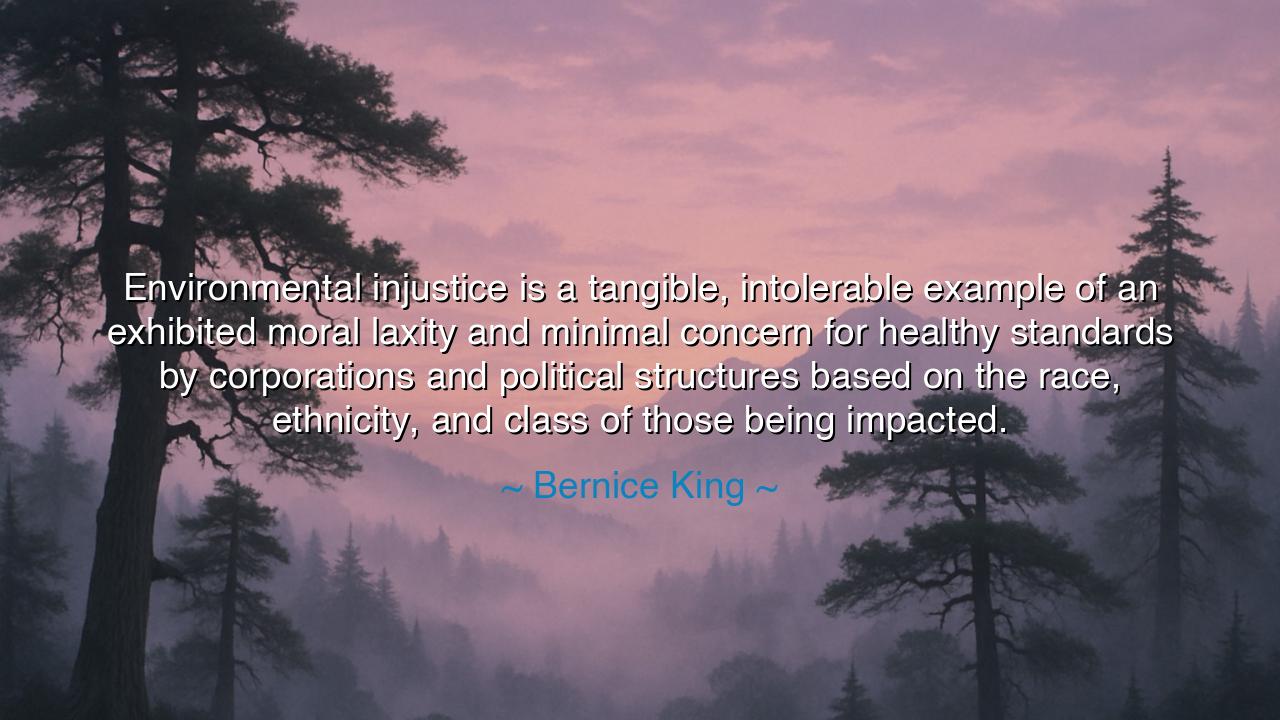
Environmental injustice is a tangible, intolerable example of an
Environmental injustice is a tangible, intolerable example of an exhibited moral laxity and minimal concern for healthy standards by corporations and political structures based on the race, ethnicity, and class of those being impacted.






The words of Bernice King, daughter of the great prophet of justice Martin Luther King Jr., strike with the weight of thunder: “Environmental injustice is a tangible, intolerable example of an exhibited moral laxity and minimal concern for healthy standards by corporations and political structures based on the race, ethnicity, and class of those being impacted.” Here, she names with fearless clarity a truth long whispered among the poor and marginalized—that the poison of pollution, the siting of factories, the dumping of waste, and the neglect of clean water are not borne equally by all, but fall most heavily upon those who are least able to resist.
At the heart of her saying lies the indictment of moral laxity. Corporations, eager for profit, and governments, driven by expedience, too often choose the path of least resistance: to place their burdens upon the weak. Where the poor live, there the smokestack rises; where the powerless dwell, there the toxic dump is laid. Bernice King unmasks this not as accident, but as injustice—rooted in race, ethnicity, and class. It is the failure of moral vision, the refusal to uphold the sacred duty of stewardship, the cowardice of choosing to harm those whose voices are least heard.
History provides us with tragic witnesses to this truth. Consider the crisis of Flint, Michigan, where poisoned water flowed into the homes of thousands, many of them poor and Black. Decisions made to cut costs resulted in lead leaching into the pipes, sickening children and scarring lives. Long after the danger was known, leaders delayed, dismissed, and denied. This was not merely environmental negligence; it was environmental injustice, for such neglect would never have been tolerated had the victims been wealthy or powerful. Bernice King’s words echo through Flint’s story, naming it for what it is: a moral failure.
Yet her words also echo more ancient tragedies. In the Roman Empire, the wealthy drank water carried in aqueducts of stone, while the poor in crowded districts drew from leaden pipes and polluted wells. The empire’s grandeur was built upon the suffering of those least protected. So it is in every age: the measure of a society is not in how it treats its strong, but in how it safeguards its weak. Environmental injustice, then, is the latest form of an old disease: the powerful exploiting the powerless.
The intolerable nature of this injustice lies not only in the harm it causes, but in what it reveals of the human heart. To turn one’s face from poisoned neighborhoods, to permit the children of the poor to breathe foul air, is to declare that their lives are worth less. It is to elevate profit above people, convenience above compassion, and prejudice above justice. It is, as King declares, the outward sign of a minimal concern for healthy standards—a sign that society has drifted far from righteousness.
The lesson is both simple and severe: a people cannot claim to be just while allowing environmental injustice to persist. To heal this wound, we must demand accountability from corporations, transparency from governments, and protection for the vulnerable. We must insist that clean air, safe water, and unpoisoned soil are not privileges but rights—rights that belong to all, regardless of race, class, or creed.
Therefore, children of tomorrow, hear Bernice King’s wisdom: do not let your hearts grow callous to the cries of those who suffer silently beneath smokestacks and pipelines. Stand where they stand, speak where they cannot speak, and demand justice where it is denied. For to fight environmental injustice is not merely to heal the earth, but to heal the soul of humanity itself. And know this: only when justice flows like water and righteousness like a mighty stream will the circle of life be whole and holy again.






AAdministratorAdministrator
Welcome, honored guests. Please leave a comment, we will respond soon